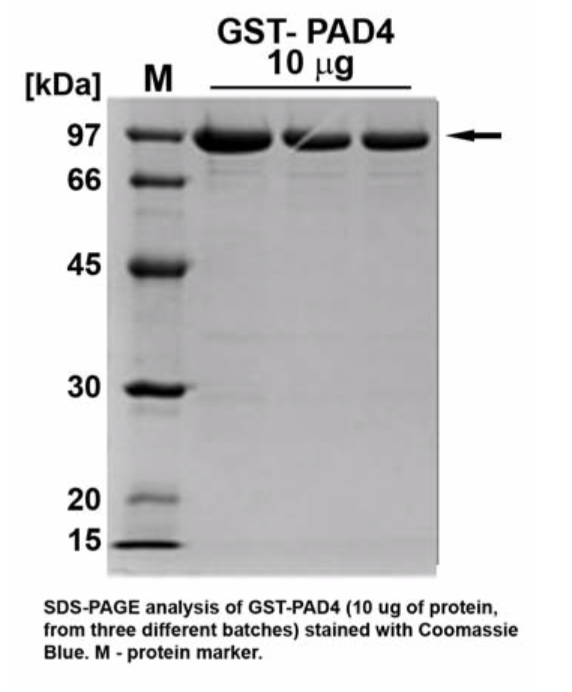PAD4
 |
The process of citrullination is mediated by the family of endogenous peptidylarginine deiminases (PADs). The guanidino‐modifying enzymes belong to the amidinotransferase superfamily and are designated PAD1‐4 and PAD6. All enzymes are cytosolic except for PAD4 (formerly known as PAD5) which has an ability to reside within the nucleus. PAD4 is a calcium dependent homodimer catalyzing the conversion of specific arginine residues to citrulline. PAD4 substrates include histones H2A, H3, and H4, whose post‐translational modifications has been associated with activation as well as repression of transcription, and therewith can modulates processes such as apoptosis in cancer.HPLC fluorometric method with N‐dansyl‐glycyl‐L‐arginine have proven to be useful tools for characterization of PAD4, having similar kinetic properties to the natural substrates. Additionally, to its pivotal role in the citrullination of peptides and proteins, PAD4 itself was discovered to be frequently recognized as an antigen in RA patients. It has previously been reported that a small subset of anti‐PAD4 autoantibodies can exert a significant effect on the PAD4 activity. PAD4 has also been implicated in several other diseases including multiple sclerosis, Alzheimer’s disease, glaucoma, and cancer. |
| Product Name |
Recombinant human PADI4/PAD4 protein |
| Databanks |
UniProt: Q9UM07 / IUBMB: EC 3.5.3.15. (BRENDA) / NCBI RefSeq Gene ID: 23569 / PDB: 1WD8 |
| Reference |
Structural basis for Ca(2+)‐induced activation of human PAD4. Arita K, Hashimoto H, Shimizu T, Nakashima K, Yamada M, Sato M. Nat Struct Mol Biol. 2004 Aug;11(8):777‐83. PMID:15247907 |
Technical information
| Source |
Active recombinant N‐terminal GST‐tagged protein expressed in E. coli |
| Purification method |
Glutathione sepharose affinity chromatography, MonoQ ion‐exchange chromatography, size exclusion chromatography |
| Molecular weight |
~102 kDa (including GST‐tag) |
| Amount |
40 μg / batch specific |
| Purity |
batch specific (≥85‐90% estimated by SDS‐PAGE) |
| Formulation |
50 mM phosphate buffer, pH 7.5, containing 0.5 M sodium chloride, 0.5 mM EDTA, 2% glycerol |
| Shipping |
Dry ice |
| Storage |
- 80°C. Avoid freeze/thaw cycles by aliquoting protein |
| Product use |
All H&G Ltd. products are for research use only. Not for use in diagnostic procedures. Small volumes may occasionally become entrapped in the seal of the product vial during shipment and storage. If necessary, briefly centrifuge the vial on a tabletop centrifuge to dislodge any liquid in the container`s cap. Certain products may require to ship with dry ice and additional dry ice fee may apply. |
